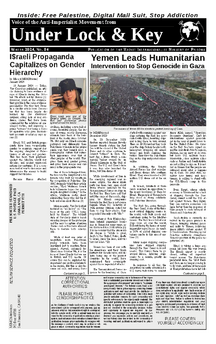
Notes on Advancing the Struggle Inside: Defeating the Gangster Mentality
What is a gangster? Simply a word, an idea? No Gangster is a psychology, a mentality.
Six things, in varying degree, regardless of locale, are always present in penal institutions: authorities (the badge), prisoners (captives), oppression, resistance, manipulation and violence. Oppression and manipulation are the badges' primary tools for controlling prisons. Captives have recourse to resistance and violence. The gangster is both target and aspiration for the badge and captives alike; if only for different reasons.
The badge sees gangsterism as a necessary evil. The "convict code" is based on gangsterism. The badge uses this to great effect. For example, misinformation offered by a "friendly" badge. There is no doubt a badge can call any captive a snitch, or worse, and be believed. Many reason that the badge does have access to every captive's file. What possible purpose could they have in lying to a gangster?
The badge's main concern is control. Controlling prisoner populations is most effective when the system can take advantage of pre-existing mechanisms, such as gangsterism or convict code. In such cases oppression seems organic, correct course of action instead of manipulation. More often than not a gangster learns information, suspicions emerge, questions asked, investigations follow. At the very least a captive's credibility is destroyed; at the extreme are ostracization and violence. This is not only true for the badge. Captives also manipulate gangsterism. A gangster's word has merit, more so than the badge's. Here too manipulation appears organic. A gangster's suspicions sway other captives' opinions so that character assassination due to personal enmity is all too familiar. The issue is not the manipulation but rather the lack of resistance.
Gangster is the pillar of lumpen communities. Eir honor, integrity are above reproach. Knowing this the badge whispers in the right ears and later watches captives eating one another like sharks in a small pond. At present, the rules of gangsterism are at the service of the badge. Changing the prevailing culture of captive vs. captive violence and badge collaboration is a serious problem to be resolved in prison today. Does this mean abandoning gangsterism? Gangsterism is tied up in all kinds of capitalist principles: machoism, classism, patriarchy, etc. Yet, it is based in resisting the system: noble seed of revolutions. Understanding the forces at play is necessary for combating corrupted gangsterism, because gangsterism can be a stepping stone to revolutionary mentality.
Every social environment evinces a subjection-manipulation cycle: subjection to rules, norms, expectations, and manipulation through rewards and negative consequences. Prisons are no different, neither is criminal intercourse. Capitalism for general society, gangsterism for captives. To bring gangsterism back to its revolutionary core we can turn to the democratic method – unity, criticism, unity.
Gangsterism is at the badge's service not only because of manipulation disseminated through gangsters but by lumpen divisions. In prison, far more than in society, lumpen become isolationists and separatists. Latinos with Latinos, further segregated by northern or southern affiliations or otherwise. Identical processes follow for all other lumpen. These divisions create barriers to communication, distrust and steady tensions. The badge plays on STG (Security Threat Group, a Homeland Security terrorist categorization term, also found in FBI documents referring to Brown Berets and Black Panther Party members or supporters) affiliations and nation prejudices as much as they do gangsterism and with the same end in view – greater control. Unity is the only real response. The badge is unified against us captives in their efforts. We, on the other hand, are barely unified against each other. First and foremost, gangsterism should be centered on opposition and resistance to the badge. Captive vs. badge.
Gangsters must be extra critical with all information received from the badge. Nine out of ten times the badge doesn't tell you anything for your benefit. Information disseminated in the service of penological interests. Consider how many times the badge has warned you about a major shake down or offered to hold your contraband? They are always engaged in exercising more control. Beginning from a united oppositional front – captives vs. badge – it becomes possible to derail the subjection-manipulation cycle. Criticism is the second stage in this process; one must analyze eir motive, endgame and method of manipulation.
From unity in opposition and criticism of intelligence being gifted us we turn to unity in response. This last stage of the democratic method is determined on a case by case basis. Every prison is distinct in character. Gangsterism is not corrupted everywhere in the exact same degrees. In some facilities badge collaboration is excessive, in others captive vs. captive violence is the commanding concern. In progressing the struggle, captives must be able to unite against the badge. This means moving beyond nation prejudices and STG allegiances. This constitutes the hardest step in our struggle.








